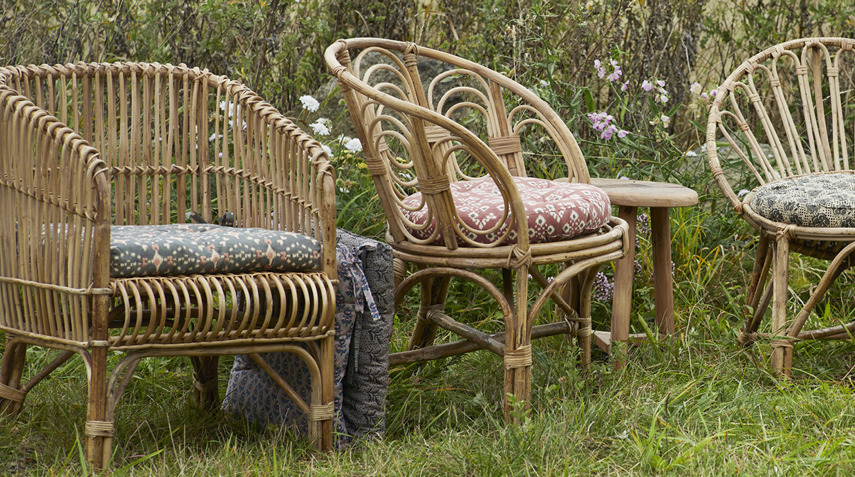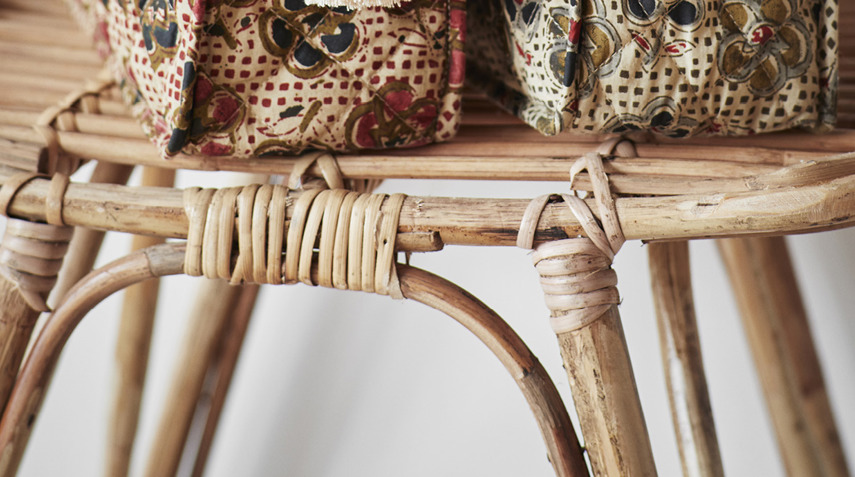Bamboo chairs have a way of making a room feel calm, fresh and grounded. They whisper rather than shout, yet they carry a presence that is hard to ignore. Pair this with a meaningful sustainability profile and you have a category of seating that is both stylish and responsible.

Why bamboo makes sense for seating
Bamboo is a grass, not a timber. That single fact changes the conversation. It grows to maturity in three to five years, compared with decades for most hardwoods, and can be harvested without killing the plant. New shoots keep rising from the same root system, which supports soil health and reduces erosion. During growth, bamboo stores carbon quickly, then keeps it locked in while it serves as furniture.
Durability is the surprise here. Good bamboo chairs are not flimsy. The fibres are long and strong, with tensile strength that rivals steel by weight when engineered into laminates. In practical terms that means a dining chair that can handle daily use, a lounge chair that feels solid when you shift your weight, and an outdoor armchair that does not sag.
Resource efficiency is strong too. Offcuts from culm processing can be pressed into boards and veneers. Many makers use water-based finishes and low-formaldehyde adhesives, which helps indoor air quality. And because the natural colour of bamboo sits near pale honey or soft straw, it takes stain evenly without heavy pigment.
Cost often lands in a sweet spot. You can find entry level models for small flats and premium hand-tied pieces for design lovers. Either way, a well-made bamboo chair gives a lot of visual warmth for the money.
Design language: from coastal calm to Japandi minimalism
Bamboo carries a relaxed elegance that pairs well with modern interiors. The material sits happily alongside polished concrete, terrazzo, linen, boucle and even lacquered cabinetry.
- Minimalist spaces: clean-lined laminated frames with straight legs and a gentle rake to the back feel sleek. Keep the finish matte and the silhouette simple.
- Coastal or Mediterranean: curved arms, steam-bent elements and cane-woven backs make rooms feel lighter. Whitewashed walls and sandy textiles support the look.
- Japandi: low profiles, quiet tones and uncluttered shapes let bamboo’s grain speak. Add stoneware, paper lamps and a single branch in a vase.
- Mid-century inspired: splayed legs, spindle backs and amber oil finishes suit teak and walnut companions without mimicking them.
Colour is a powerful tool. Natural pale bamboo brightens a room. Caramelised bamboo, which is heat treated to deepen tone, brings warmth and contrast. Black-stained bamboo sharpens lines and reads more architectural. Cushions in moss green, terracotta or slate create a measured palette that feels current.
There is also texture. Smooth laminated members look tailored. Split bamboo wrap, knotted joints and open cane panels add tactility. Mixing both finishes in one piece can be interesting, for example a lamella frame with a handwoven seat.
The science beneath the beauty
Structural bamboo chairs fall into two broad types. Some use whole culms or split sections joined with pegs, dowels and bindings. Others use engineered bamboo boards that are laminated, shaped and joined like timber furniture.
Engineered bamboo arrives as strips that are planed, glued and pressed into boards under heat. Grain orientation varies. Edge-grain boards show fine linear lines. Strand woven boards pack fibres into a dense matrix with exceptional hardness. For chairs, edge-grain laminations often give the best balance of weight and strength, while strand woven parts excel for rails and feet that take knocks.
Adhesives matter. Look for E1 or CARB Phase 2 emissions ratings for formaldehyde. Many high quality manufacturers state the glue system openly. Water-based lacquers and hardwax oils keep VOCs low and allow easier refinishing later. Kiln drying to the right moisture content reduces splitting and helps joints stay tight.
Joinery is the quiet hero. Mortice and tenon, finger joints at laminations and well-placed cross braces raise rigidity. Screws into end grain are a weak point in any chair, so a model that uses mechanical fasteners in combination with proper joints will last longer.
Indoor versus outdoor use
Bamboo can live outside, but only with the right treatment and care. Raw bamboo absorbs moisture, which can swell fibres and invite mould. For garden or balcony use, prioritise pieces sealed with UV-resistant exterior finishes, often a marine-grade varnish or outdoor oil. Stainless steel fixings help prevent rust stains. A breathable cover keeps rain off, and storing chairs inside during winter extends life.
If your patio gets full sun, think about colour. Dark-stained bamboo heats up faster, which stresses finishes. Pale tones stay cooler and show less fading. For very exposed sites, aluminium or teak may be better, with bamboo used in a covered area.
Indoors, bamboo is easy. It is stable in typical home humidity ranges. In a conservatory or orangery, blinds and ventilation help manage temperature swings. Felt pads on feet prevent scuffs on hardwood floors and reduce the chance of hairline cracks from impact.

Comfort and ergonomics
A beautiful chair that hurts your back ends up in the spare room. Comfort hinges on seat height, depth, back angle and support.
- Seat height: 43 to 46 cm works for most dining tables at 73 to 76 cm. Taller users may prefer 47 cm.
- Seat depth: 40 to 45 cm supports thighs without cutting circulation behind the knees.
- Back angle: 100 to 110 degrees between seat and back gives a relaxed posture for lounge chairs. Dining chairs benefit from a slightly more upright angle, around 100 to 103 degrees.
- Lumbar: a gentle curve at the lower back or a cushion that sits at belt height makes a big difference.
Weave choices influence feel. A tight cane or paper cord seat has a little give, which many find comfortable for long meals. Laminated slats offer spring if shaped with a subtle flex. If you prefer a firmer base with a plush top, look for models with removable cushions, preferably with zip covers for washing.
Styling ideas for different rooms
- Dining room: pair six slim bamboo side chairs with a chunky oak or stone table for balance. Mix two armchairs at the heads of the table for presence.
- Home office: a bamboo task chair with a curved back softens a tech-heavy setup. Add a wool throw over the back for texture.
- Reading corner: a low bamboo lounge chair, floor lamp and small side table, plus a stack of books. Keep cushions generous.
- Entryway: a narrow bamboo bench, woven basket under for shoes, and a mirror above. Simple, useful, tidy.
- Conservatory: a set of bamboo armchairs with light cushions in natural linen. Plants in terracotta pots tie everything together.
A single chair can also be a statement. Place one sculptural piece by a window with a plant and a small rug to create a moment.
Comparing materials at a glance
|
Material |
Renewable resource |
Typical weight |
Repairability |
Weather resistance |
Maintenance |
Price range in UK |
Visual character |
|---|---|---|---|---|---|---|---|
|
Bamboo |
Yes, 3 to 5 year growth cycles |
Light to medium |
High, parts can be rewrapped or refinished |
Moderate with exterior finish |
Low indoors, moderate outdoors |
£80 to £600+ |
Warm, linear grain, modern or rustic |
|
Oak |
Yes, slow growth |
Medium to heavy |
High |
Good with treatment |
Moderate |
£120 to £1,200+ |
Classic, strong grain |
|
Aluminium |
No, but recyclable |
Very light |
Medium, structural fixes are harder |
Excellent |
Low |
£70 to £800+ |
Sleek, contemporary |
|
Polypropylene |
No, recyclable depends on local streams |
Light |
Low, cannot refinish |
Excellent |
Very low |
£30 to £300 |
Smooth, uniform colour |
Prices vary by design, craftsmanship and finish quality, but the pattern holds. Bamboo sits between hardwood and metal in weight and upkeep, while offering a renewable story that resonates with modern homes.
What to look for when shopping
- Clear material specification: solid culm, laminated bamboo, or strand woven. Each has a different look and performance profile.
- Finish type: water-based lacquer, hardwax oil, or exterior varnish for outdoor models.
- Adhesive emissions: E1 or CARB Phase 2 labelling for low formaldehyde.
- Joinery: mortice and tenon where possible, dowels and corner blocks for reinforcement.
- Load rating: a realistic static load above 110 kg for dining chairs inspires confidence. Many quality models rate to 130 kg or higher.
- Stability: no rocking, even leg lengths, protective glides fitted.
- Warranty and aftercare: spares for feet, replacement cushions, rewrapping service for woven parts.
- Certifications: FSC or equivalent for any timber components, ISO 9001 or similar for factory quality systems, and OEKO-TEX on textiles.
- Fit for space: measure table heights and arm clearances. Consider stackability if you entertain often.
Try before you buy when possible. Sit for ten minutes. Listen for creaks, feel for pressure points and check for wobble on a hard floor.
Care, cleaning and long term maintenance
Weekly care is simple. Dust with a soft cloth. Pick up grit before it abrades surfaces. A slightly damp microfibre cloth deals with smudges. Avoid bleach, ammonia and silicone polishes. Mild soap diluted in warm water is fine, followed by a dry wipe.
Every few months, check joints. Tighten screws gently without over-torquing. If an oil finish looks dry, refresh with a thin coat of hardwax oil, applied with a lint-free cloth, left to penetrate, then buffed. For lacquered pieces, use a furniture polish that states it is safe for lacquers, or just a clean dry cloth.
Manage humidity. Aim for 40 to 60 percent indoors. Very dry air can open tiny cracks. Very damp rooms invite mould. If mould appears, ventilate, wipe with a solution of white vinegar and water, then dry thoroughly. Address the cause, not just the mark.
Outdoor chairs benefit from a spring check. Lightly sand any rough patches with 320 grit paper, wipe clean and recoat with exterior oil or varnish as per the maker’s instructions. Store cushions indoors when not in use.
Repairs are often straightforward. A loose cane strand can be re-woven or tacked by a specialist. Minor dents in laminated parts can be steamed out with a damp cloth and an iron on low heat, then refinished. Deep structural cracks call for professional attention.
Longevity and circular thinking
Bamboo shines when cared for. Many pieces last decades, gaining patina that reads as character. Because surfaces can be renewed, owners can refresh a set of dining chairs rather than replacing them. Re-webbing seats after ten years keeps comfort high and waste low.
End of life planning matters. Unfinished bamboo can be composted or chipped for mulch, though most furniture carries some finish. Better options include resale, donation, or refurbishment. Some brands run take-back schemes. Upholstered elements should be separated for correct recycling streams. A screw-based construction, rather than only glue, helps with disassembly.
Real-world cost and value
The value case is strong when you look past the sticker price. A £250 bamboo dining chair with proper joinery and a low VOC finish can outlast a £120 particleboard option by many years. Over a decade, that means lower waste and lower total cost.
Energy inputs during manufacturing are competitive. Pressing and laminating require heat, but the raw material grows quickly and needs less land. Freight weight is lower than many hardwoods, which can trim transport emissions, especially when shipped flat in efficient packaging.
Bamboo chairs exemplify sustainable living by marrying sophisticated design with environmental stewardship, creating timeless furnishings that honour both style and planet.
If budget is tight, consider mixing. Two bamboo head chairs paired with four simple polypropylene seats gives interest without overspend. Over time, add more bamboo pieces as funds allow.
Common myths
- Bamboo chairs are flimsy: poor construction is flimsy, not the material. Engineered bamboo with good joinery is very strong.
- All bamboo furniture is automatically eco-friendly: responsible sourcing and low emission adhesives matter. Look for clear standards, not just green labels.
- Bamboo is hard to clean: it is straightforward. Mild soap, soft cloth, and sensible humidity are the key steps.
- Only suits boho interiors: the material reads differently with finish and form. Minimalist, Scandinavian and urban schemes all work beautifully with the right shape.

DIY and customisation
If you enjoy hands-on projects, bamboo rewards careful work. Drilling requires sharp bits and moderate speed to prevent tear out. Use painter’s tape over exit points. Sand progressively, 180 to 320 grit, to avoid scratchy surfaces. Always sand with the grain or along the lamination lines.
Finishes vary by look. Hardwax oil brings a natural feel with a soft sheen. Water-based polyurethane adds toughness with little yellowing. Stains should be tested on offcuts, as heat-treated bamboo can take colour differently to natural stock.
Cushions are an easy way to personalise. Box cushions with zip covers let you wash textiles seasonally. Consider natural fillings like wool or recycled polyester. Piping in a contrasting colour adds a tailored edge.
If you have a classic bamboo frame with tired wrap, a craftsperson can rewrap joints with rattan peel or paper cord. It is satisfying to save a frame that still has life in it.
Choosing between styles: quick pointers
- Ladder-back dining chair: supportive, minimal visual weight, good airflow on hot days.
- Tub armchair: cosy shape for reading corners, works with a lumbar cushion.
- Cantilever base: subtle flex, modern look, pair with a simple table to show off the profile.
- High stool: kitchen islands gain texture and warmth, check seat height carefully against worktop.
Bringing it all together at home
Start with one space. If it is the dining room, choose chairs first and let the table respond. If it is a lounge, pick a single bamboo accent chair and mirror its tone in a tray, a lamp base or a picture frame. Keep the palette tight. Let texture do the heavy lifting.
Lighting matters. Bamboo glows under warm white light around 2700 to 3000 K. A floor lamp with a fabric shade softens edges and highlights the grain. Plants are natural companions. Broad-leaf species echo the organic feel of the material.
Most of all, make the chairs work for your life. They should invite use, not stage a set. A well-chosen bamboo chair will age gracefully, carry the marks of good times and still look ready for the next conversation.





